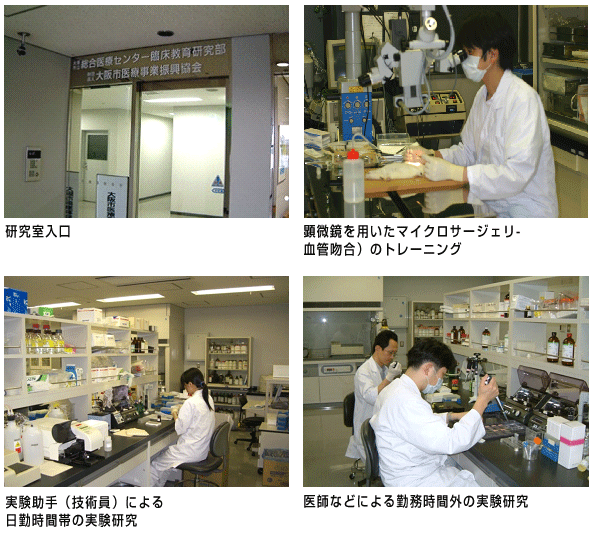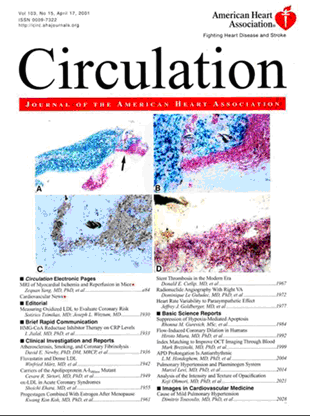|
|
当院では、将来の医療を担う若い人材の育成と診断と治療に関わる臨床研究を進める目的で、大学の研究室に匹敵する立派な研究施設を備えた臨床研究センター(1995年に動物実験室が、1997年に研究室)が併設されています。
循環器内科でも、併設された研究室で、臨床に直結する多数の臨床研究を積極的に行い、国内外の学会や国際誌に多数掲載しています。

 循環器内科の研究内容 循環器内科の研究内容
動脈硬化進展の機序や急性冠症候群の病態解明では、アンジオテンシン変換酵素(ACE)
やC型ナトリウム利尿ペプチド(CNP)などの血管作動性物質の動脈硬化進展メカニズムへの関与や、ヒト冠動脈の動脈硬化進展に伴い内皮細胞のテロメア長が高度に短縮することなどを報告しました(Circulation, 1996 & 1998; J Hypertens, 1997 & 1999; Arterioscler Thromb Vasc Biol, 2004)。 ヒト冠動脈のプラーク不安定化における好中球の役割について初めて明らかにするとともに (Circulation, 2002)、急性冠症候群の急性期では血漿中酸化LDL値が高値であることも初めて報告し、Ciculationの表紙(下図)に掲載されました (Circulation, 2001)。さらに臨床病態での酸化LDLの関与やレクチン様酸化LDL受容体(LOX-1)との関係について報告しました(J Diabetes, 2002; Am Heart J, 2004; Arterioscler Thromb Vasc Biol, 2006; Cardiovasc Res, 2006; Cir J, 2007)。またプラーク不安定化の発症機序の1つとして、プラーク内出血が関与し、プラーク内出血部位のマクロファージにヘモグロビンスカベンジャーレセプター(CD163)やヘムオキシゲナーゼの発現が高度であることを報告しました (Eur Heart J, 2009; Hum Pathol, 2013)。さらにその長期予後について2017年米国心臓病学会で発表しています。

近年、血栓吸引デバイスの進歩により急性冠症候群の責任病変に存在する血栓の正確な評価が可能となり、我々は、急性心筋梗塞症例より得られた血栓を用いて病理学的検討を行っています。血栓の構成成分は主に血小板、赤血球、フィブリン、そして炎症細胞(好中球など)であり、血栓に占める赤血球の割合をもとに3群に分類し臨床経過と比較検討を行ったところ、赤血球成分が高度な血栓群は、心筋再灌流の指標が有意に低値であり発症6ヶ月後の左室リモデリングの進行と有意に関連し、さらに吸引血栓に占める赤血球の割合はカテーテル治療時の遠位塞栓発生を規定する独立した因子の一つであることを報告しました (Eur Heart J, 2012; JACC Cardiovasc Interv, 2013; J Atherocler Thrombus, 2013)。 急性冠症候群の発症を予知するための種々の血液バイオマーカーの研究では、前述の酸化LDLのみならず、活性化好中球から放出される酸化酵素であるミエロペルオキシダーゼ(MPO)や、マクロファージに発現するネオプテリン、活性化マクロファージや好中球に発現する骨髄関連蛋白複合体(MRP8/14)などのバイオマーカーと冠動脈や頸動脈の不安定プラークとの関連性、およびこれらのバイオマーカーの心事故発生の予測因子としての重要性などについて報告しています(Heart, 2007 & 2008 & 2010; Am J Cardiol, 2010; J Atherocler Thrombus, 2010; Atherosclerosis, 2010; Cir J, 2010)。さらにLDLの酸化抑制作用などHDLの主要な抗動脈硬化作用を担っているパラオキソナーゼ(PON-1)に注目しミエロペルオキシダーゼ(MPO)との関連を報告しました(Atherosclerosis, 2013)。またパラオキソナーゼ(PON-1)が、ステント留置した安定狭心症の予後予測因子として重要であることを2014年の米国心臓病学会で発表しています。さらに近年注目されているタコツボ心筋症で、レクチン様酸化LDL受容体(LOX-1)やミエロペルオキシダーゼ(MPO)の関与について、2016年米国心臓病学会で発表をしています。さらにマクロファージに発現するネオプテリンの二尖弁での発現について、2017年米国心臓病学会で発表しました。 近年増加傾向にある大動脈弁狭窄症の発症機序の解明については、大動脈弁狭窄症の進行が著しい透析例に注目して検討を行っています。透析例では、酸化酵素である血漿中ミエロペルオキシダーゼや酸化LDLが有意に上昇していることや、透析例の大動脈弁は、非透析例の大動脈弁組織に比べ組織中のミエロペルオキシダーゼが高度に発現していることを報告しています(Hemodial Int, 2013;J Heart Valve Dis, 2013)。さらに大動脈弁狭窄症の急速な進行に大動脈弁組織の出血やその防御反応としてのヘモグロビンスカベンジャーレセプター(CD163)やヘムオキシゲナーゼ(HO-1)の関与していることを報告し(Hemodial Int, 2014)、さらに、最近注目されています2尖弁の発症機序に動脈弁組織の出血やその防御反応としてのヘモグロビンスカベンジャーレセプター(CD163)の関与について、2016年米国心臓病学会で発表をしています。
 業績 業績
- Naruko T, et al. C-type natriuretic peptide in human coronary atherosclerotic lesions. Circulation, 94, 3103-3108, 1996
- Ohishi M, et al. Upregulation of angiotensin-converting enzyme during the healing process after injury at the site of percutaneous transluminal coronary angioplasty in humans. Circulation, 96, 3328-3337, 1997
- Ohishi M, et al. Enhanced expression of angiotensin-converting enzyme is associated with progression of coronary atherosclerosis in humans. J Hypertens, 15, 1295-1302, 1997
- Komatsu R, et al. Neointimal tissue response at sites of coronary stenting in humans: macroscopic, histological, and immunohistochemical analyses. Circulation, 98, 224-233, 1998
- Inoue M, et al. Vascular endothelial growth factor (VEGF) expression in human coronary atherosclerotic lesions : possible pathophysiological significance of VEGF in progression of atherosclerosis. Circulation, 98, 2108-2116, 1998
- Ohishi M, et al. Relative localization of angiotensin-converting enzyme, chymase and angiotensin II in human coronary atherosclerotic lesions. J Hypertens, 17, 547-553, 1999
- Chen M, et al. Activation-dependent surface expression of LOX-1 in human platelets. Biochem Biophys Res Commun, 282, 153-158, 282, 153-158, 2001
- Kakutani M, et al. Accumulation of LOX-1 ligand in plasma and atherosclerotic lesions of Watanabe heritable hyperlipidemic rabbits: identification by a novel enzyme immunoassay. Biochem Biophys Res Commun, 282, 180-185, 2001
- Ehara S, et al. Elevated levels of oxidized low density lipoprotein show a positive relationship with the severity of acute coronary syndromes. Circulation, 103, 1955-1960, 2001
- Ehara S, et al. Pathophysiological role of oxidized low-density lipoprotein in plaque instability in coronary artery diseases. J Diabetes Complications, 16, 60-64, 2002
- Naruko T, et al. Neutrophil infiltration of culprit lesions in acute coronary syndromes. Circulation, 106, 2894-2900, 2002
- Matsuo T, et al. chymase expression in Helicobacter pylori-associated gastritis. Histopathology, 43, 538-549, 2003
- Ogami M, et al. Telomere shortening in human coronary artery diseases. Arterioscler, Thromb, Vasc Biol, 24, 546-550, 2004
- Hai E, et al. M. Alterations of endothelin-converting enzyme expression in early and advanced stages of human coronary atherosclerosis. Int J Mol Med, 13, 649-654, 2004
- Ikura Y, et al. Expression of the hepatic endothelin system in human cirrhotic livers. J Pathol, 204, 304-310, 2004
- Kayo S, et al. Oxidized low-density lipoprotein levels circulating in plasma and deposited in the tissues: comparison between Helicobacter pylori- associated gastritis and acute myocardial infarction. Am Heart J, 148, 818-825, 2004
- Ikuta T, et al. Immunolocalization of platelet glycoprotein IIb/IIIa and P-selectin and neutrophil-platelet interaction in human coronary unstable plaques. Int J Mol Med, 15, 573-577, 2005
- Ikura Y, et al. Expression of angiotensin II type 1 receptor in human cirrhotic livers: its relation to fibrosis and portal hypertension. Hepatol Res, 32, 107-116, 2005
- Naruko T, et al. C-Type natriuretic peptide and natriuretic peptide receptors are expressed by smooth muscle cells in the neointima after percutaneous coronary intervention. Atherosclerosis, 181, 241-250, 2005
- Hinagata J, Kakutani M, Fujii T, Naruko T, Inoue N, Fujita Y, Mehta JL, Ueda M, Sawamura T. Oxidized LDL receptor LOX-1 is involved in neointimal hyperplasia after balloon arterial injury in a rat model. Cardiovasc Res, 69, 263-271, 2006
- Naruko T, et al. Persistent high levels of plasma oxidized low-density lipoprotein after acute myocardial infarction predict stent restenosis., Arterioscler, Thromb, Vasc Biol, 26, 877-883, 2006
- Ikura Y, et al. Localization of oxidized phosphatidylcholine in nonalcoholic fatty liver disease: impact on disease progression. Hepatology, 43, 506-514, 2006
- Shirai N, et al. Expression of endothelin- converting enzyme, endothelin-1 and endothelin receptors at the site of percutaneous coronary intervention in humans. J Hypertens, 24, 711-721, 2006
- Shirai N, et al. Endothelin-converting enzyme expression in the neointima after percutaneous coronary intervention. Osaka City Med J, 52, 29-37, 2006
- Yamashita H, et al. Elevated plasma levels of oxidized low-density lipoprotein relate to the presence of angiographically detected complex and thrombotic coronary artery lesion morphology in patients with unstable angina. Circ J, 71, 681-687, 2007
- Adachi T, et al. Neopterin is associated with plaque inflammation and destabilisation in human coronary atherosclerotic lesions. Heart, 93, 1537-1541, 2007
- Miyamoto S , et al. Increased serum levels and expression of S100A8/A9 complex in infiltrated neutrophils in atherosclerotic plaque of unstable angina. Heart, 94, 1002-1007, 2008
- Suekane T, et al. Enhanced expressions of endothelin-converting enzyme and endothelin receptors in human colonic tissues of Crohn's disease. J Clin Biochem Nutr, 42, 126-132, 2008
- Yunoki K, et al. Enhanced expression of haemoglobin scavenger receptor in accumulated macrophages of culprit lesions in acute coronary syndromes. Eur Heart J, 30, 1844-1852, 2009
- Yunoki K, et al. Relation of elevated levels of plasma myeloperoxidase to impaired myocardial microcirculation after reperfusion in patients with acute myocardial infarction. Am J Cardiol, 105, 922-929, 2010
- Sugioka K, et al. Elevated levels of neopterin are associated with carotid plaques with complex morphology in patients with stable angina pectoris. Atherosclerosis, 208, 524-530, 2010
- Katashima T, et al. Enhanced expression of the S100A8/A9 complex in acute myocardial infarction patients. Circ J, 74, 741-748, 2010
- Nakagawa M, et al. A decline in platelet activation and inflammatory cell infiltration is associated with the phenotypic redifferentiation of neointimal smooth muscle cells after bare-metal stent implantation in acute coronary syndrome. J Atheroscler Thromb, 17, 675-687, 2010
- Naruko T, et al. Increased expression and plasma levels of myeloperoxidase are closely related to the presence of angiographically-detected complex lesion morphology in unstable angina. Heart, 96, 1716-1722, 2010
- Sugioka K, et al. Neopterin and atherosclerotic plaque instability in coronary and carotid arteries. J Atheroscler Thromb, 17, 1115-1121, 2010
- Yunoki K, et al. Erythrocyte-rich thrombus aspirated from patients with ST-elevation myocardial infarction: association with oxidative stress and its impact on myocardial reperfusion. Eur Heart J, 33, 1480-1490, 2012
- Yunoki K, et al. Relationship of thrombus characteristics to the incidence of angiographically visible distal embolization in patients with ST-segment elevation myocardial infarction treated with thrombus aspiration. JACC Cardiovasc Interv, 6, 377-385, 2013
- Kitabayashi C, et al. Positive association between plasma levels of oxidized low-density lipoprotein and myeloperoxidase after hemodialysis in patients with diabetic end-stage renal disease. Hemodial Int, 17, 557?567, 2013
- Yunoki K, et al. Association between hemoglobin scavenger receptor and heme oxygenase-1-related anti-inflammatory mediators in human coronary stable and unstable plaques. Hum Pathol, 44, 2256-2265, 2013
- Yunoki K, et al. Gender-specific correlation between plasma myeloperoxidase levels and serum high-density lipoprotein-associated paraoxonase-1 levels in patients with stable and unstable coronary artery disease. Atherosclerosis, 231, 308-314, 2013
- Wada S, et al. Myeloperoxidase and progression of aortic valve stenosis in patients undergoing hemodialysis. J Heart Valve Dis 22, 640-647, 2013
- Yunoki K, et al. Thrombus aspiration therapy and coronary thrombus components in patients with acute ST-elevation myocardial infarction. J Atheroscler Thromb, 20, 524-537, 2013
- Inaba M, et al. Enhanced expression of hemoglobin scavenger receptor and heme oxygenase-1 is associated with aortic valve stenosis in patients undergoing hemodialysis. Hemodial Int,18, 632-640, 2014
- Wada S, et al. Relationship between oxidative stress and aortic valvestenosis in humans: an immunohistochemical study. Osaka City Med J. 59, 61-67, 2013.
- Yunoki K, et al, Gender-specific correlation between plasma myeloperoxidase levels and serum high-density lipoprotein-associated paraoxonase-1 levels in patients with stable and unstable coronary artery disease. Atherosclerosis. 231, 308-314, 2013
- Nakagawa M, et al. Enhanced expression of natriuretic peptide receptor A and B
in neutrophils of culprit lesions in patients with acute myocardial infarction.
Mol Med Rep. 16, 3324-3330, 2017.
- Yoshiyama T, et al. Neopterin and Cardiovascular Events Following Coronary Stent Implantation in Patients with Stable Angina Pectoris. J Atheroscler Thromb. 25, 1105-1117, 2018
|

